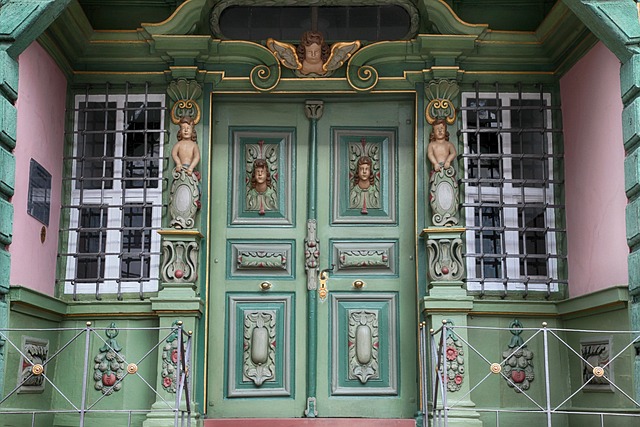Custom historic door replacement is a meticulous process crucial for successfully restoring historical buildings. It involves precise measurements, crafting components specific to the building's architecture, and understanding era-specific construction methods. This specialized service ensures new doors perfectly replicate the original style, design, and materials, maintaining the property's historic integrity. By blending contemporary features with historical charm, these doors enhance security, energy efficiency, and accessibility while preserving the building's architectural heritage. Successful installations incorporate period-appropriate hardware, ensuring both strength and aesthetic harmony. Custom historic door replacement is an ideal way to restore homes' historical charm while providing modern functionality.
“Discover the art of professional door installation, where precision meets history. When replacing doors in historic buildings, every detail matters. This article guides you through the process of ensuring your custom historic door replacement fits seamlessly with the building’s unique layout and architectural charm.
From assessing historical details to choosing the right doors and mastering installation techniques, we’ll explore why this approach is crucial for longevity and preservation. Learn how to maintain these treasures, ensuring they stand strong for generations to come.”
Understanding Custom Historic Door Replacement: The Importance of Precision Fitting
When it comes to restoring historical buildings, every detail matters, and this includes the doors. Custom historic door replacement is a specialized service that requires precision and an eye for detail. It involves installing doors that match the original style, design, and materials used in the building’s construction, ensuring it blends seamlessly into the existing architectural layout.
Precision fitting is crucial to achieving this seamless integration. The doors must be tailored to fit perfectly within the door frames, aligning with any unique angles or contours of the historical structure. This meticulous process includes taking accurate measurements, considering factors like wall movement and thermal expansion, and crafting each door component to spec. Proper fitting not only ensures the door operates smoothly but also preserves the building’s historic integrity, making it a vital step in any restoration project.
Assessing the Building's Historical Layout and Architectural Details
When undertaking a custom historic door replacement, meticulously assessing the building’s historical layout and architectural details is paramount. This involves studying the structure’s original design plans, identifying unique features like trim, moldings, and paneling styles, and understanding the era-specific construction methods used. By immersing oneself in these intricacies, professionals can ensure that new doors not only fit physically but also harmonize aesthetically with the rest of the building.
Proper alignment and fitting go beyond simple measurement. It requires a deep appreciation for the architectural narrative the building tells. For instance, doors might need to be angled or fitted with specific hardware to complement existing elements. This level of craftsmanship ensures that the replacement doors not only serve their functional purpose but also preserve the historical integrity and charm of the structure, making them seamless additions rather than discordant notes in the building’s symphony.
Choosing Doors That Respect the Past While Meeting Modern Functionality Requirements
When it comes to professional door installation, especially in historically significant buildings, finding a balance between preserving the past and meeting modern functionality requirements is paramount. Property owners and developers often seek custom historic door replacement solutions that blend seamlessly with the existing architecture while offering enhanced security, energy efficiency, and accessibility.
This involves careful consideration of materials, styles, and finishes that respect the building’s original design elements. Crafting doors to exact historical specifications ensures they align perfectly with the structure’s overall aesthetic. Simultaneously, incorporating contemporary features like advanced locking mechanisms, weatherstripping, and insulated cores addresses modern needs for improved performance, reduced energy loss, and enhanced safety, thereby preserving both the building’s historical charm and its utility in today’s world.
Installation Techniques for Ensuring Proper Alignment and Longevity
When installing custom historic door replacements, artisans employ meticulous techniques to align doors perfectly with a building’s unique layout. This involves careful measurement and marking of existing door frames, ensuring they are level, plumb, and square. Specialized tools like laser levels and framing squares are used to make precise adjustments, creating an accurate fit that respects the historical integrity of the structure.
Beyond proper fitting, successful installation includes securing doors with appropriate hardware designed for both strength and aesthetic harmony. This may involve using historic-style hinges and locks that mirror the original door fittings, ensuring not only longevity but also preserving the door’s character and place within the building’s historical tapestry.
Maintaining and Preserving Your Custom Historic Doors Over Time
In conclusion, professional door installation is key to preserving a building’s historical layout. By understanding precision fitting, assessing architectural details, choosing suitable doors, employing correct installation techniques, and maintaining them over time, we can ensure that custom historic door replacements not only respect the past but also meet modern functionality requirements. This meticulous approach safeguards the integrity of historic structures while enhancing their longevity and aesthetic appeal.
